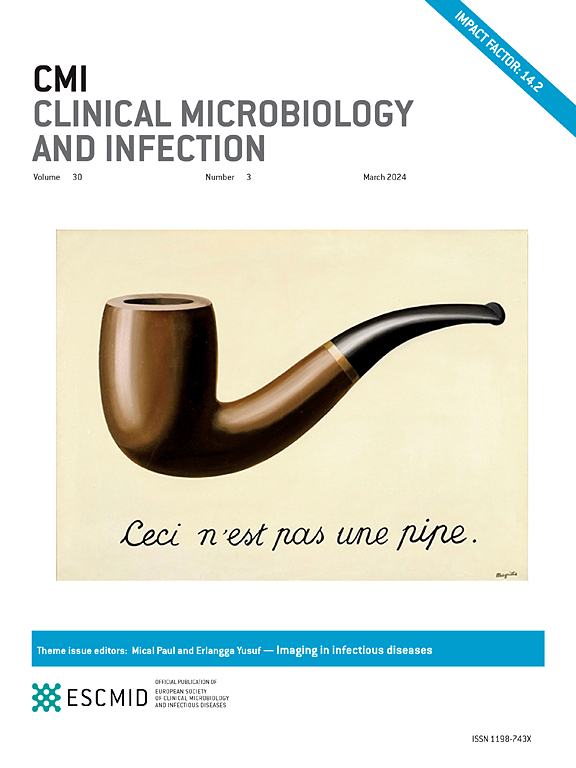评估孕妇B群链球菌检测新算法的准确性及其对早发新生儿B群链球菌感染的影响
IF 8.5
1区 医学
Q1 INFECTIOUS DISEASES
引用次数: 0
摘要
目的:评估一种检测孕妇B群链球菌(GBS)定植的新算法的准确性,该算法是根据美国妇产科医师学会和美国微生物学会的指导方针设计的。此外,本研究旨在确定该算法对早发新生儿B群链球菌病(GBS-EOD)病例的潜在影响。方法:从2021年3月至2024年3月,使用ESwab™培养基采集妊娠35-37周的孕妇阴道直肠样本5034份。样品在Todd Hewitt肉汤中培养,在Granada培养基上传代,并使用DiaSorin Simplexa™GBS Direct Assay进行检测(如果Ct≤35则呈阳性)。对青霉素过敏妇女GBS分离株进行药敏试验。gbs阳性妇女接受产时抗生素预防。该研究还审查了同一时期的GBS-EOD病例。结果:938例(18.6%)孕妇感染GBS。其中625份(66.6%)培养阳性,313份(33.4%)培养阴性,但肉汤富集naat阳性。没有样品为肉汤富集naat阴性和培养阳性。肉汤富集naat的敏感性为100% (95% CI, 99-100%),特异性为93% (95% CI, 92-94%),阳性预测值为67% (95% CI, 67-40%),阴性预测值为100% (95% CI, 100-100%)。两种方法的结果基本一致(Cohen’s kappa =0.76 (95% CI, 0.74-0.79))。45株GBS分离株均对青霉素、氨苄西林和万古霉素敏感,对红霉素耐药的占44.4%(20/45),对克林霉素耐药的占40%(18/45)。在研究期间,5563例活产新生儿中未发现GBS-EOD病例(95% CI: 0-0.054%)。结论:该算法快速、灵敏、特异,可有效识别产时抗生素预防候选药物;可能减少新生儿感染,降低GBS-EOD发病率和新生儿死亡率。整合肉汤富集NAATs对阴性培养样品进行验证,可加强检测和预防工作。本文章由计算机程序翻译,如有差异,请以英文原文为准。
Assessing the accuracy of a novel algorithm for group B Streptococcus detection in pregnant women and its impact on early-onset neonatal group B streptococcal infections
Objectives
The objective of this study was to assess the accuracy of a novel algorithm—designed in accordance with guidelines from the American College of Obstetricians and Gynecologists and the American Society for Microbiology—for detecting group B Streptococcus (GBS) colonization in pregnant women. Additionally, the study aimed to determine the potential impact of this algorithm on early-onset neonatal group B streptococcal disease (GBS-EOD) cases.
Methods
From March 2021 to March 2024, 5034 vaginal-rectal samples were collected from pregnant women at 35 weeks to 37 weeks gestation using ESwab™ medium. Samples were cultured in Todd Hewitt broth, subcultured on Granada medium, and tested with the DiaSorin Simplexa™ GBS Direct Assay (positive if Cycle threshold ≤ 35). Antimicrobial susceptibility testing was conducted on GBS isolates from penicillin-allergic women. GBS-positive women received intrapartum antibiotic prophylaxis. The study also reviewed cases of GBS-EOD during the same period.
Results
In total, 938 (18.6%) pregnant women were colonized with GBS. Among these, 625 samples (66.6%) were culture-positive, whereas 313 (33.4%) were culture-negative, but broth-enriched nucleic acid amplification test (NAAT)-positive. No samples were broth-enriched NAAT-negative and culturepositive. The broth-enriched NAAT demonstrated a sensitivity of 100 (95% CI: 99—100) and a specificity of 93 (95% CI: 92—94), along with a positive predictive value of 67 (95% CI: 67—70) and a negative predictive value of 100 (95% CI: 100—100). There was substantial agreement between methods (Cohen's kappa = 0.76 [95% CI: 0.74—0.79]). All 45 GBS isolates from penicillin-allergic women were susceptible to penicillin, ampicillin, and vancomycin, whereas 44.4% (20/45) were resistant to erythromycin, and 40% (18/45) were resistant to clindamycin. No cases of GBS-EOD were detected among the 5563 live newborns during the study period (95% CI: 0—0.054%).
Discussion
The novel algorithm was rapid, sensitive, and specific, effectively identifying candidates for intrapartum antibiotic prophylaxis, potentially reducing newborn infection and lowering GBS-EOD incidence and neonatal mortality rates. Integrating broth-enriched NAATs to verify negative culture samples could enhance detection and prevention efforts.
求助全文
通过发布文献求助,成功后即可免费获取论文全文。
去求助
来源期刊
CiteScore
25.30
自引率
2.10%
发文量
441
审稿时长
2-4 weeks
期刊介绍:
Clinical Microbiology and Infection (CMI) is a monthly journal published by the European Society of Clinical Microbiology and Infectious Diseases. It focuses on peer-reviewed papers covering basic and applied research in microbiology, infectious diseases, virology, parasitology, immunology, and epidemiology as they relate to therapy and diagnostics.

 求助内容:
求助内容: 应助结果提醒方式:
应助结果提醒方式:


